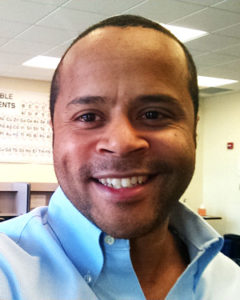By Eric Brown
This is part of NEA's series Voices of Pride: The LGBTQ Experience in Schools 50 Years After Stonewall.
 While attending the 2006 Gay Games sports festival in Chicago, I noticed the unique name of one of the participants. It was the same name of a student I had in my ninth-grade biology class in 1999.
While attending the 2006 Gay Games sports festival in Chicago, I noticed the unique name of one of the participants. It was the same name of a student I had in my ninth-grade biology class in 1999.
Indeed, that young student I knew was now a grown-up. After talking with him, I found he had matured into a proud, gay black male … studying to be a teacher!
His journey to get to be where I saw him in 2006 is one that many students may have experienced. A journey of remarks and insults, frequently not even directed at you, that remind you to stay hidden, to stay in the closet.
I recall one day during my ninth-period class, he entered the room donning a key ring as an earring. One of his best girlfriends and classmates, also black, exclaimed for all to hear: “Stop acting like a f-g!” My jaw hit the floor upon hearing a term I never thought I would hear uttered in class.
At the start of the semester, students and I determined classroom expectations. I was clear about my disdain for demeaning phrases that create unsafe, unwelcoming learning environments. I recall in particular a phrase that some students would use to “diss” a classmate: “That is so gay.” I did my diplomatic best to prevent students from dissing one another with phrases like that.
One of the agreed-upon consequences of not meeting classroom expectations was that any student who uttered such a phrase would be required to meet with me for 20 minutes after school. It was considered a detention. Most students adhered to the expectations. Those who did not were quick to apologize and accepted the consequences.
In class that day, I immediately interrupted the so-called playful interaction between the two students and assigned the girl her meeting. She protested that she was just joking and that they are friends and she meant nothing by it. Still, I insisted we meet, but that we do so after the winter break that was to begin soon.
It was during these meetings that I would share stories from the book “The Shared Heart: Portraits and Stories Celebrating Lesbian, Gay, and Bisexual Young People,” by Adam Mastoon. I hoped these stories would help students understand the impact bullying and harassment can have on others their age. The book also highlights the diversity of people who identify as LGBTQ. Usually, after the meetings, students stopped using offensive words or phrases, at least in front of me.
Fast forward to post-break. As I’m overseeing a ninth-period study hall, I receive an announcement from the main office that the mother of the young girl who is supposed to meet with me wants to speak with me immediately. The parent arrives at the door and begins to berate me for making her child serve a detention “for using a word like that.” She proceeds to proclaim very loudly that “if the boy is a f-g, then he needs to get used to people calling him that.”
It was my first year as a teacher. Not once did I think I would hear an adult use language like that in a school, let alone during school hours and within hearing range of a room full of teenagers. On top of that, what she said did not make sense to me because this young black male was an athlete and masculine in the traditional sense. She had no way of knowing his sexual orientation.
To de-escalate the situation, and preserve my new job as a teacher, I asked the mother to continue the conversation with me in the presence of the principal. Long story short, the principal had my back, and supported me, my students, and our classroom expectations.
So, what should be taken from this story?
First, we always need to hold high expectations of behavior for our students.
Second, we need to know how to deal with parents and guardians who may not share the same expectations for behavior as are established at schools and other learning institutions.
Third, we need to work with and demand support from our administrators when it comes to creating safe, welcoming learning environments for all students.
And finally, even those of us who are champions, advocates, and/or who self-identify have biases that can prevent us from seeing who our students are and who our students can become.
Eric Brown is a biology teacher in Evanston, Illinois and a member of NEA’s executive committee.






